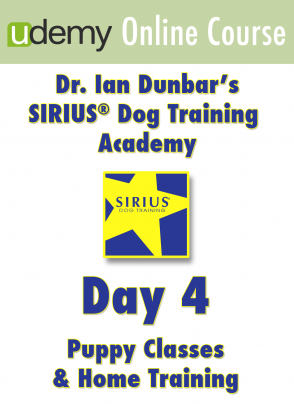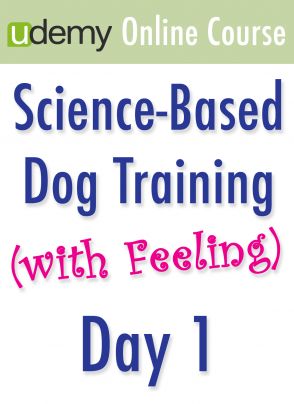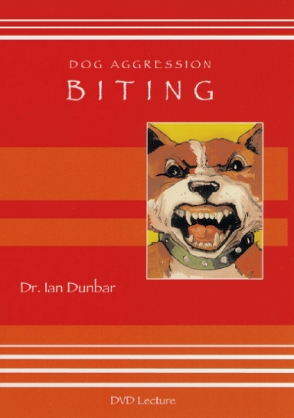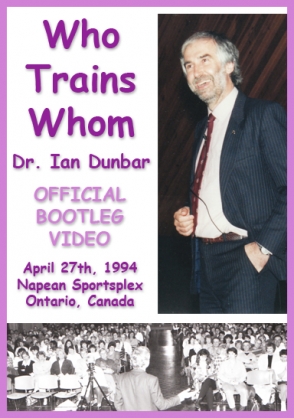This little book is intended primarily as a brief but comprehensive guide to puppy training, containing information about socialization, temperament training and behavior modification as well as tips for teaching basic manners.
AN EXCITING NEW CURE FOR SEPARATION ANXIETY
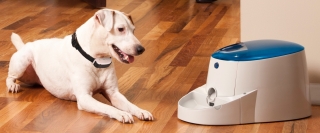
Given that we developed the AutoTrainer nearly 26 years ago, I find it surprising that only recently, (largely due to feedback from dog owners and trainers), we have discovered that the device is extremely effective for the rehabilitation of dogs with severe separation anxiety.
We designed the AutoTrainer to reduce recreational barking and other vocalizations, which it does extremely effectively, as evidenced by reviewing the barking history and plotting the decrease in number of barks per day. Our original research showed that in addition to reducing barking, the dogs paced less and spent more time lying down, usually very close to the AutoTrainer, which of course, all makes sense because that’s where the food rewards are delivered. At the time, my co-inventor, (a developmental psychologist with a recent interest in dog cognition), remarked that he felt that our test shelter dogs were “attaching” to the machine — bonding — pretty much like Harry Harlow’s isolation-reared monkeys that, in the absence of their real mothers, attached (both physically and psychologically) to a metal wire frame (surrogate “mother”) covered in terry cloth.
The Harlow experiments dramatically underscored the beyond-crucial importance of early experience, especially hugging and handling to prevent severe mental trauma and behavior problems. Given the choice between food and a wire frame to hug, the motherless baby monkeys chose the wire frame. I recently reread the Harlow research papers and found the results to be extremely disturbing in the same way that I find it really sad that our test dogs appeared to be bonding with a machine! But I guess this only advertises just how desperately lonely and stressed some dogs are when left at home alone.
As you know, I just loooove ruthless objective quantification of behavior and speed of behavior-change and so, I was delighted to receive hard numbers from users showing an appreciable reduction in number of barks and activity as measured using a Bark & Activity Counter. Additionally, some owners reported a decrease in housesoiling and destructive chewing, which one would also expect, if the dog is spending more time settled down rather than wandering around the house looking to create mischief. However, feedback from owners who used high-tech means to view their dogs when left at home alone was the most revealing. Dogs that were previously viewed as being extremely agitated and anxious were now seen to be peacefully settled alongside the AutoTrainer. In fact, my latest nickname for the AutoTrainer is “Buddy”, as in “Get your dog a buddy — an electronic Buddy!”
Understanding how the AutoTrainer works helps shed some light on its beneficial effect for separation anxiety. The AutoTrainer is a fully automatic, reward-based training device that trains your dog for you, whether you are present or not; no prior training is necessary for you or your dog. Simply fill the food hopper with some dry kibble, synch the collar with the AutoTrainer, press Teach Me mode and leave the machine to work its magic while you are home, or away. Use a portion of your dog’s daily ration of kibble to autotrain; no treats and no extra food and so, no weight gain. For the AutoTrainer to function, the collar must be turned on and in synch. However, the dog only needs to wear the collar if using the AutoTrainer to reduce barking.
Teach Me Mode — to condition the dog to a progressive secondary reinforcer.
Using nothing more than kibble and science, this miraculous little machine monitors barking throughout the day and rewards dogs for being calm and quiet for progressively longer periods via a 24-tone cascade culminating in delivery of one or two pieces of kibble. The tone-cascade becomes a conditioned, progressive secondary reinforcer: 1. Dogs quickly learn that the cascade of tones predicts kibble delivery; and 2. Since the tones progressively decrease in periodicity and increase in pitch as kibble delivery nears, the dog learns to predict the expected wait-time for a food reward at any stage in the cycle.
The length of the tone sequences increases with each cycle and so, with successive trials, your dog will lie down quietly and calmly for longer and longer periods in anticipation of fewer and fewer food rewards. If the machine has been running all day, dogs happily settle down for over an hour for the prospect of just one food delivery. This alone causes a considerable reduction in barking because dogs that are lying down bark less than those that are sitting, standing, walking or running about.
Whenever the dog barks or sets of the Tilt Alarm, the AutoTrainer emits a soft “Uh-Oh” sound. However, there are no consequences for barking or making physical contact; the tone-cascade proceeds uninterrupted until food delivery.
Calm Me Mode — to specifically decrease the frequency of barking by 1. Reinforcing silence and 2. Delaying food-delivery after each bark.
Whenever the dog causes the AutoTrainer to emit the “Uh-oh” response, the current tone sequence is reset to the beginning and so, the dog has to wait longer for food delivery. Essentially the “Uh-Oh” sound is a Delay of Reward Marker, which dogs try to avoid and so, barking decreases further. The Bark History display screen allows you to see how often your dog barks while you’re away, allowing you to track your dog’s progress and see how quickly daily barking decreases. The reduction in number of barks per day (and hyperactivity) is much quicker and more pronounced than with drug therapy.
Both Teach Me and Calm Me modes produced a number of unexpected effects, notably the dog’s calmness and closeness to the machine and especially, the machine’s apparent “psychological comfort” for the dog. In retrospect, calmness and closeness are pretty easily explained. Obviously, the dog wants to remain close to the machine because that’s where food delivery happens and so, the dog wanders about less and settles in close proximity more. However, it is a little more difficult to explain why many dogs appear to be bonding, or attaching, to the machine. My best guesses are:
1. The AutoTrainer is interactive — feedback changes in response to the dog’s behavior
2. The AutoTrainer’s feedback acknowledges the dog’s very existence
3. The AutoTrainer is there for the dog all day long; always communicating and always training.
The machine runs on a pretty complicated algorithm (essentially, my brain, on a chip, inside the machine). In a sense, the algorithm is interactive because each cycle, the AutoTrainer’s response is adjusted, based on the dog’s responses. To give some examples: Most of the time, successive cycles progressively increase in length but not always. Sometimes, cycle-length remains the same and occasionally cycle-length is decreased, depending on how quickly the dog eats the dispensed kibble. If the dog decides to snooze, the machine snoozes too. And when the dog wakes up, the machine wakes up. What a companion!
We debated at great length whether or not to include the “Uh-Oh” feedback (but with no consequences) in Teach Me mode. I am so glad we did because I think it offers some insight into what is going on in the dog’s brain. Barking decreases, calmness and closeness increase and dogs appear to bond with the machine whether in Teach Me or Calm Me mode. Whereas the “Uh-Oh” sound functions as a DRM in Calm Me mode, there are no consequences for barking or molesting the machine in Teach Me mode. The AutoTrainer simply lets the dog know that it heard the bark or felt the bump. In the words of my co-inventor, it’s as if the machine is responding, “I heard you”, or “I felt you”. I think the machine is saying, “I know you’re there. You’re not alone. I’m here too!” In the dog’s home-alone, social void, someone (actually something) is listening. Of course, we’ll never ever know for certain what’s going on in the dog’s head, i.e., what our dogs are thinking and feeling, any more than we know for certain what our spouse, child, or friend is thinking and feeling. We can only observe behavior. And when we do, dogs certainly appear to be much happier, calmer, more contented and decidedly less stressed when they have an electronic Buddy for company.
As I reviewed the many effects of the AutoTrainer, I was intrigued that the machine provides for the four basic needs of kenneled (or left-alone) dogs as recommended in Kelly Dunbar’s Open Paw Shelter Behavior Program Minimal Mental Health Guidelines, i.e., Education, Entertainment, Comfort and Companionship.
Education — teaches dogs to bark less, decreases activity, increases calmness
Entertainment — dogs become captivated by the machine — the canine soaps!
Comfort — Doesn’t provide physical comfort but most definitely provides psychological comfort affording peace of mind for dogs when left at home alone
Companionship — dogs appear to attach/bond to the AutoTrainer. Sad but true.
I never tire of watching previously agitated, reactive, anxious, or over-the-top dogs eventually become mesmerized by the machine — mesmerized by science. Conditioning is subconscious and therefore so difficult to resist. I too become mesmerized watching the machine work its magic.
Since the AutoTrainer Instruction Manual is a bit of a dinosaur, I have provided simple instructions below:
INSTRUCTIONS FOR USE OF THE AUTOTRAINER TO RELIEVE SEPARATION ANXIETY
Feed your dog ONLY from the AutoTrainer. NO food bowl and absolutely NO handfed treats. 1. For the first couple of days, position the AutoTrainer (in Teach Me mode) next to where you are sitting to get your dog accustomed to eating from the machine. 2. Then, progressively move the AutoTrainer a little farther away from you each day until the machine is in a different room to get your dog accustomed to eating from the machine when you are home but out of sight. 3. For the next few days, position the AutoTrainer next to your dog’s bed in a quiet room with some calm music playing. Make a point of walking around the house and repeatedly leave the house for short but progressively longer periods. Each time you come back indoors, first turn off the music and then the AutoTrainer. Each time before leaving the house, first turn on the music and then the AutoTrainer. In time, both the dog’s bed and the music will become additional conditioned relaxation cues. 4. Now you are ready for the AutoTrainer to work its magic while you are away. The AutoTrainer may be used in either Teach Me mode, or Calm Me mode if excessive barking is a problem. Turn on the music and then AutoTrainer before leaving the house in the morning and turn off the music and AutoTrainer as soon as you return. In no time at all, your dog will regain the confidence to enjoy spending time at home alone with its newfound electronic Buddy at which point, you may resume handfeeding kibble as rewards for teaching manners and tricks.
The current best retail price for the AutoTrainer is available from: PetExpertise.com


